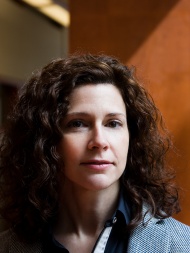Kari Hoffman, associate professor of psychology and biomedical engineering, has received a National Institutes of Health BRAIN Initiative grant to measure how the brain records and manages what we learn from different experiences over time, and to adapt an existing computational model of memory for the primate brain. The five-year grant from the National Institutes of Neurological Disorders and Stroke totals more than $3.8 million.

People experience learning in complex scenarios and the real world, where they have the benefit—or complication—of considering location, nearby companions and objects, immediate goals and memories of past situations. What they learn, and which brain circuits are responsible, may depend on the interplay of these factors in the moment and also later.
The set of interconnected brain regions that give rise to memory for past events is fairly well identified, but how neurons in these regions give rise to memories is far less clear, Hoffman said. A traditional learning theory called Complementary Learning Systems says that specific areas of the brain contribute to memories differently depending on the age of the memory. CLS relies heavily on assumptions about brain circuits in nonprimate subjects, where flexible learning and the accompanying expanded brain circuitry were not considered.
Hoffman and her collaborators developed an augmented reality environment to study how learning adapts over time and in different situations. They will track and manipulate changes in responses of neural ensembles—groups of neurons firing together—across the brain during learning and sleep in primate subjects. The measured brain behavior will be compared to what a formal computational model of memory predicts.
“More generally, because these brain regions are known to differ in their susceptibility to healthy aging, neurodegenerative disease, brain trauma and the most common type of seizures, a clearer understanding of their independent contributions to naturalistic memories offers an important step for future interventions.” — Kari Hoffman
Once the computational model is updated to reflect the primate brain, developed by Anna Schapiro, assistant professor of psychology at University of Pennsylvania, Hoffman’s team will address assumptions in the CLS theory by using new technologies to measure and compare the brain’s fine circuit behavior. “We will use high-density, multi-site recordings of microcircuits in the hippocampus and connected neocortical areas to test two major aspects of memory theory in need of resolution,” Hoffman said. The researchers are the first to test the prediction that differences in how events are learned will lead to distinct streams of information flow—going through or skirting the hippocampus.
“It will determine whether memories get reallocated to different brain regions over time, or whether certain brain structures are always responsible for particular aspects of memories,” said Hoffman, who also is a faculty affiliate at the Vanderbilt Brain Institute. “More generally, because these brain regions are known to differ in their susceptibility to healthy aging, neurodegenerative disease, brain trauma and the most common type of seizures, a clearer understanding of their independent contributions to naturalistic memories offers an important step for future interventions.”
Hoffman and her collaborators will also explore whether specific brain regions play a role in memory retrieval as a function of either the age of the memory or of the specific nature of the task being performed. “We will use closed-loop stimulation to explore the necessity of each region during recall and the role of coordinated activity between hippocampus and neocortex for recall across memory age and type,” Hoffman said. “From these experiments, we will disambiguate several competing theories of the division of labor across nodes in the memory network, testing our neural-circuit findings against our expanded computational model.”